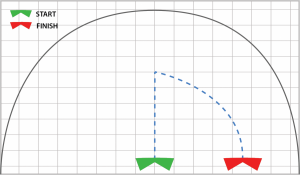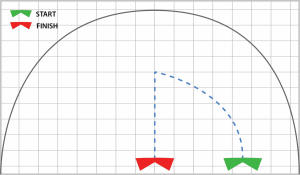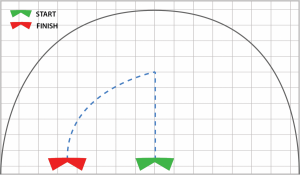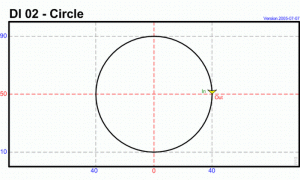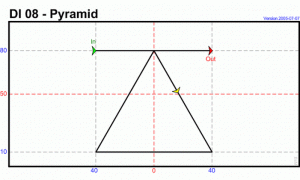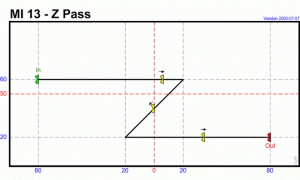After six plus years of doing sport kite workshops and clinics (both dual and quad kites), I’ve had a lot of opportunities to work with different personalities and skill sets while teaching… One of the things that I see most frequently with beginning, and even some more advanced fliers, is a lack of intent in their kite flying.
Let me clarify with an over-simplified break down of the mindsets that come into play here…
- First time flier – no idea what it feels like yet, no goals yet, just about to have an experience.
- Novice flier – has basic control, but may be “just trying to keep it up”, correcting what the kite gives them.
- Experienced flier – has more control, but may be stuck straight downwind, practicing individual skills.
- Master flier – solid control, more visible flight paths and combinations of maneuvers with varied complexity.
Now truly, there is no wrong way to fly a kite as long as it’s safe for all involved, and you’re having fun… In my experience, you gotta have the joy.
However, this article is for those fliers who want to take it to the next level, to take the skills they’re learning and apply them in specific ways to increase your overall skill set, add context and most importantly for performance-oriented fliers, a number of combinations or snippets of flight program… And this brings us to a clear differentiation between what I’ll loosely term as “leisure fliers” versus “sport fliers”.
End of the day, you gotta do what fulfills you – so if you feel like I’m missing the mark here, skip past this and go fly how you like. 😉
“What are you thinking about when you launch your kites?”
That is one of the most common questions I ask a flier who is struggling after they learn their kite flying basics, to which the most common replies are generally “trying to keep the kite up” or “taking off“, and while there’s nothing wrong with that (again – fly for personal joy), those answers are indicative of the obstacles at hand… It’s a reactive state, as opposed to being pro-active… The kite acts, and we react with perpetual corrections.
I can’t stress enough, any enjoyable state of kite flying is a good one… But if you want to really increase your learning curve and gain more overall control, I suggest you fly with intent.
Launching – instead of this being a simple “off the ground” exercise, try thinking about the simple launch in these terms…
- Visualize a space 20 feet above where you are launching from, think about that space, GO TO IT.
- Be prepared when you reach that space, and choose which way you want your kite to go (left or right).
- Pick a place on the ground (right or left side), fly to it and land.
Now this may not seem like much, but try that simple goal-oriented flight plan (3 steps) as shown below…
Now please understand, at this point it’s not important HOW you get from points A to B, just that you make the attempt – you can always refine the HOW later.
What are we trying to accomplish with this idea?
Well, instead of thinking about something as finite as “trying to keep your kites up”, you’ve stepped back to think about a bigger goal…
- By doing something measurable, we applied our skills toward a specific goal and accomplished it (effort over quality).
- We did several things in a row to achieve that goal, first step toward stringing together techniques and patterns (combinations).
- We set the path, defined our intent and looked ahead – sort of like riding a bicycle (pro-activity).
- We set the stage and acted, rather than improvising and reacting at every turn.
Now bear in mind, the value isn’t in trying it once or twice – try repeating it, changing it, improving it… That’s where the real improvement will come.
Granted, this was a very simple example, but probably a fair one for someone who still considers themselves a beginner.
Turning up the heat with precision compulsories
So now we understand that WE can define the kites action and have a format in which to improve our kite flying skills more rapidly – the trick now is to expand that format by adding additional flight patterns, generally referred to as precision figures, compulsories or maneuvers… And what a lot of folks don’t know is that most precision compulsories were specifically designed to focus on a particular combination of skills, in sequence, increasing in difficulty as you work your way through them.
Even if you’re not a competitor or fancy yourself a “leisure flier”, there’s no rule against flying shapes as an exercise… You can ALWAYS free fly, learning a few more skills will only help you enjoy it more deeply in the long run.
Precision compulsories are usually released to the kiting community as a collective effort from the IRBC (International Rules Book Committee), a group made up of veteran sport kite judges and fliers from the AKA (American Kitefliers Association), STACK (Stunt Team And Competitive Kiting) in Europe and AJSKA (All-Japan Sport Kite Association) – while they are generally available on the web sites for each organization, I’m particularly fond of the resource put together by Roy Reed… It’s one thing to see a static maneuver on paper, and another entirely to see it fully animated!
The full index of Roy’s animations – http://reeddesign.co.uk/kites/iskcb/index.html
For the purpose of this article (targeted toward newer fliers), I’ll highlight a sampling of the maneuvers below…
Remember, these are just examples from which you can improvise your own paths, but the compulsories above can give you a place to start… Again, working toward one’s ability to move their kite from A to B with intent.
Playing your kite flying deck of cards
I found a lot of success during my sport kite competition years (1991 to 2008) but believe it or not, I only had ONE fully choreographed or planned performance (Bugs Bunny with Rev) and every other individual routine I flew, ballet or precision, was pretty much improvised.
Why, or how, you ask?
Well quite simply, I don’t have much patience for practicing individual routines so instead, I developed and used a mental “deck of cards”… Whereas some fliers might look at a routine as many, many, many pieces, I started using a handful of combinations or sequences in my performance.
Example…
- Long ground pass left to right…
- Fly a big up circle and exit on the same ground pass…
- Land on the right side the window…
- Launch straight into a left square…
- Finish in the right ground pass again…
- Land in the same place as before.
What we have here is a sequence or combination, and it can be flown…
- Larger or smaller
- Slower or faster
- With steps added
- With steps removed
Those four choices can be applied to match your music, application or the type of kite you’re using and on it’s own, I visualize it as a single playing card from a deck of many different ones… This means while some pilots might be somewhere in the sky and thinking about the next turn, I’m thinking about where my kite is and which playing card I can apply or adapt for my next sequence.
Some of the things I’ve noticed…
- Time seems longer somehow, like I have more mental space to operate, my mind is more calm – these mini-plans give me freedom to focus on the quality and timing, as well as what card I’m going to play next (long before I get there).
- With simple things like adding, removing or changing the entry or exit portion of a single card, I’m able to string together a lot of content without repeating too much, especially if you’re dealing with a 3 minute ballet performance.
- By repeating these sequences so many times, I’ve been able to do them very reliably, almost on demand – nothing like repetition and practice.
Whether or not the fliers use a deck of cards, a full routine or totally improvise, I’d argue that many top level performances that can be broken down into a winning hand of maneuvers… Try looking at 3-5 consecutive moves as a single card in the routine below, and see how many cards you can accumulate.
There are some pretty wicked maneuvers and control being applied there, but even if you take out the big tricks, you can see how effective a solid flight path can be and how things can be broken down into segments.
Now, I don’t often think about the cards unless I’m explaining it to someone else – they’re mostly ingrained, so I just enjoy the flying.
Mental process
It’s good to review your plans and think about your techniques… But, try not to over-think it.
We’re talking about flying kites after all!
There isn’t much benefit to your kite being on the ground when you want to learn – go ahead and test your wings.
I’d also like to suggest two more exercises, if you harmonize with them…
- Clear or “reset” your mind between attempts (and between cards), in a single moment, try emptying your head and just seeing where you want to go as a whole… As you build your deck of cards, you’ll be able to do this “mental clearing” between each step in a sequence, focusing on the quality of each turn.
- Clear or reset your posture – we generally accumulate tension as we try difficult things so I’ve found it to be very beneficial to literally “shake it off”, to relax my body… Tension tends to relay down the lines, I’ve found the best response when a flier is poised but relatively relaxed.
You may also find that music helps set a rhythm for your body mechanics and flight style – try setting your iPod to tunes with an open tempo, not too fast, not to slow, tracks that make you feel like swinging your hips a little… Above all, have fun with it, keep challenging yourself.
And remember – to each their own, and as long as you’re enjoying kite flying and not hurting anyone, you’re ultimately on the right track.

